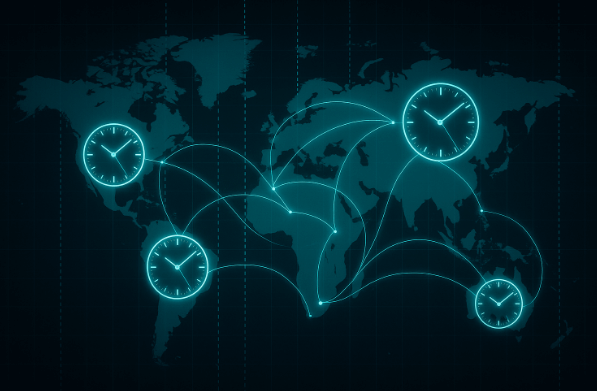How Global Time Awareness Is Changing the Way We Work, Travel, and Communicate Online

In a hyperconnected world, time is no longer just what we read from a wristwatch — it’s a dynamic element shaping the way we collaborate, travel, and live digitally. As borders blur and virtual spaces replace physical offices, understanding global time zones has become a hidden superpower for professionals, travelers, and businesses alike.
Today, every online meeting, international deal, and long-distance friendship depends on one simple skill — time coordination across borders. And thanks to modern tools like WorldClocksTime.com, managing that global rhythm has never been easier.
Let’s dive into how the awareness of world time is silently redefining how we work, communicate, and explore the planet.
1. From Local Time to Global Synchronization
Only a few decades ago, time was an entirely local experience. A shopkeeper in Delhi and a banker in New York operated on completely different schedules, and the overlap between them was almost nonexistent.
But as international business expanded and remote work took over, the world needed synchronization. Suddenly, knowing what time it was in Tokyo or Paris became as important as knowing your own office hours.
Digital tools stepped in to solve this — online world clocks, global meeting planners, and time zone converters became essential for the global workforce. Platforms like WorldClocksTime.com give people instant access to accurate, real-time data for every city in the world, bridging that invisible time gap between continents.
This shift from local to global time awareness didn’t just change how we work; it changed how we think. We no longer live in “our” time — we live in a web of interconnected clocks.
2. The Rise of Remote Work and Time Zone Intelligence
Remote work exploded after the pandemic, and with it came a new challenge: time zone chaos. Teams spread across five continents suddenly had to coordinate without confusion.
What time is it for the designer in London? When can the developer in San Francisco attend the sprint meeting? Is 9 AM in Singapore the same as 6 PM in Los Angeles?
These questions became a part of everyday work culture. Companies started hiring “time zone coordinators” or using smart scheduling tools to bridge these differences. But even then, nothing beats the simplicity of a clean interface showing you world clocks side by side — exactly what WorldClocksTime.com provides.
It’s not just about knowing the time; it’s about respecting others’ time. Global awareness encourages empathy and productivity in distributed teams. When everyone knows who’s awake, who’s resting, and who’s on a break, collaboration becomes smoother, faster, and more human.
3. Time Awareness as a Productivity Hack
Strangely enough, learning to think in multiple time zones actually makes people more productive.
Why? Because it forces planning. When you know your colleague in Germany goes offline by 6 PM their time, you prioritize communication earlier. When you understand that your client in Japan starts their day five hours before you, you can send updates overnight so they wake up to progress.
This kind of “temporal awareness” builds structure and flow into modern work routines. It’s one reason many digital nomads, freelancers, and executives swear by online time trackers and world clock dashboards.
Instead of seeing time as a limitation, they treat it as a rhythm — and tools like WorldClocksTime.com act as their metronome.
You don’t need to memorize offsets or count hours manually anymore. With just one look, you can see when the world is awake and plan your day accordingly.
4. Travel Planning in the Digital Age
The same principle of global time awareness now extends far beyond offices — it’s transforming travel itself.
Whether it’s flight scheduling, layover planning, or virtual itineraries, knowing world times is essential. A missed time conversion can cost you a flight or a business meeting.
Modern travelers use sites like WorldClocksTime.com not only to check local times but also to plan transitions between destinations. For instance, someone traveling from Mumbai to New York can quickly view both zones on one screen, reducing confusion and jet lag planning errors.
Many airlines and tourism blogs now embed world time widgets or reference tools directly in their guides because travelers expect instant clarity. After all, when your body clock says it’s midnight but the city around you is buzzing at noon, that time difference becomes very real.
5. The Psychology of Global Clocks
Interestingly, global time awareness doesn’t just help logistically — it changes our mindset.
When you constantly view multiple time zones, you start to internalize the idea that the world is bigger than your bubble. Someone is always waking up, someone is always working, and someone is always asleep.
It subtly builds patience and understanding — two qualities that global communication desperately needs.
That’s why digital clocks and dashboards aren’t just data tools; they’re cognitive reminders of global coexistence. WorldClocksTime.com exemplifies this by making time zones visually accessible, reminding users that they are part of a living, rotating world.
Every timezone you see represents lives, cultures, and stories happening in parallel. That’s a powerful realization in itself.
6. Global Business: The New Time Economy
For international businesses, time is money — quite literally.
A delayed meeting due to time confusion can cost thousands. A misaligned deadline can ruin partnerships. As organizations scale across countries, time synchronization becomes as important as financial synchronization.
That’s why many multinational firms embed world clocks in their intranets, dashboards, and digital offices. They depend on accurate global timing data to schedule launches, report deadlines, and even publish content in regional markets.
WorldClocksTime.com serves as a trustworthy resource in this ecosystem — providing precise global time insights for professionals who can’t afford to get it wrong.
From stock markets to marketing campaigns, understanding when things happen globally has turned into a measurable advantage.
7. Communication Without Confusion
We’ve all been in that awkward moment — you promise to call someone at 7 PM, only to realize it’s 4 AM for them.
Cross-border communication has turned this into a common challenge. The solution isn’t just courtesy; it’s preparation.
Messaging apps, video call tools, and even social media platforms now integrate time zone detection, but having a quick reference on a browser still beats them all.
When people use platforms like WorldClocksTime.com before scheduling, they eliminate confusion altogether. It’s not just a small utility; it’s the foundation of polite, global communication.
As the digital landscape becomes more collaborative and culturally blended, such awareness is becoming a social skill, not just a technical one.
8. Students, Freelancers, and the Global Classroom
The new generation of learners and workers is growing up with global time literacy.
Students attend online classes hosted in foreign universities. Freelancers deliver projects to clients living 10 hours apart. Even gamers schedule matches across continents.
For all these cases, being able to instantly see multiple world clocks is vital. Tools like WorldClocksTime.com give these users a frictionless way to stay aligned with the world’s rhythm.
In a sense, the global classroom runs on synchronized time. When everyone shows up at the right virtual hour, learning thrives.
And that’s why time tools have quietly become part of digital education itself.
9. The Human Side of Time Zones
Behind all the digital layers, there’s something deeply human about time awareness. It connects us beyond geography.
When you think about someone’s local time, you subconsciously respect their life — their morning coffee, their family dinner, their rest hours.
Global empathy often begins with a simple thought: “What time is it for them right now?”
That’s what makes world clocks beautiful — they’re not just mechanical displays, they’re emotional bridges. And WorldClocksTime.com captures that simplicity with a global heartbeat, ticking in harmony with billions of people.
10. What the Future of Time Awareness Looks Like
As AI, automation, and remote intelligence expand, global time awareness will evolve further.
We’re moving toward predictive scheduling — systems that automatically adjust meetings based on daylight hours, local holidays, or circadian rhythms.
Smart devices might soon integrate dynamic clocks that adapt to your international contacts. And AI assistants will analyze time zone data to optimize your productivity hours.
In this future, platforms like WorldClocksTime.com will remain the open, human-friendly layer — where anyone can visually reconnect with real-time data and ground themselves in the planet’s rhythm.
Because while AI may optimize time, only humans can appreciate it.
Boost your online performance with Alpha SEO Tools — your one-stop destination for powerful and free SEO tools! From simple tools to complex guest posting work, adding ads code to websites and guest posting, Alpha SEO Tools helps you optimize every aspect of your site with ease. Designed for bloggers, writers, and SEO professionals, our tools are fast, accurate, and completely free to use. Whether you want to improve your rankings, analyze competitors, or track your site’s performance, AlphaSEOTools.com provides everything you need to achieve top results in search engines.
Final Thoughts
Time has always been the great equalizer. No matter where we live, each of us gets 24 hours — but how we align those hours with the rest of the world defines our effectiveness.
Global time awareness isn’t a technical skill anymore; it’s a cultural one. From business calls to travel itineraries, it’s shaping how humans collaborate, move, and thrive.
So the next time you’re planning an international meeting, a global launch, or just calling a friend abroad — remember that a single glance at WorldClocksTime.com can save confusion, missed opportunities, and even strengthen relationships.





